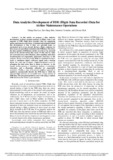JavaScript is disabled for your browser. Some features of this site may not work without it.
| dc.contributor.author | Lee, Chang-Hun | |
| dc.contributor.author | Shin, Hyo-Sang | |
| dc.contributor.author | Tsourdos, Antonios | |
| dc.contributor.author | Skaf, Zakwan | |
| dc.date.accessioned | 2018-03-12T11:45:07Z | |
| dc.date.available | 2018-03-12T11:45:07Z | |
| dc.date.issued | 2017-12-11 | |
| dc.identifier.citation | Chang-Hun Lee, Hyo-Sang Shin, Antonios Tsourdos and Zakwan Skaf. Data analytics development of FDR (Flight Data Recorder) data for airline maintenance operations. Proceedings of the 2017 IEEE International Conference on Multisensor Fusion and Integration for Intelligent Systems (MFI 2017), 16-18 November 2017, Daegu, South Korea. | en_UK |
| dc.identifier.isbn | 978-1-5090-6064-1 | |
| dc.identifier.uri | http://dx.doi.org/10.1109/MFI.2017.8170443 | |
| dc.identifier.uri | https://dspace.lib.cranfield.ac.uk/handle/1826/13074 | |
| dc.description.abstract | In this article, we propose a data analytics development to detect unusual patterns of flights from a vast amounts of FDR (flight data recorder) data for supporting airline maintenance operations. A fundamental rationale behind this development is that if there are potential issues on mechanical parts of an aircraft during a flight, evidences for these issues are most likely included in the FDR data. Therefore, the data analysis of FDR data enables us to detect the potential issues in the aircraft before they occur. To this end, in a data pre-processing step, a data filtering, a data sampling, and a data transformation are sequentially performed. And then, in this analysis, all time series data in the FDR are classified into three types: a continuous signal, a discrete signal, and a warning signal. For each type of signal, a high-dimensional vector by arranging the time series data is chosen as features. In the feature section process, a correlation analysis, a correlation relaxation, and a dimension reduction are sequentially conducted. Finally, a type of k-nearest neighbor approach is applied to automatically identify the FDR data in which the unusual flight patterns are recorded from a large amount of FDR data. The proposed method is tested with using a realistic FDR data from the NASA's open database. | en_UK |
| dc.language.iso | en | en_UK |
| dc.publisher | IEEE | en_UK |
| dc.rights | Attribution-NonCommercial 4.0 International | * |
| dc.rights.uri | http://creativecommons.org/licenses/by-nc/4.0/ | * |
| dc.subject | Time series analysis | en_UK |
| dc.subject | Maximum likelihood detection | en_UK |
| dc.subject | Nonlinear filters | en_UK |
| dc.subject | Data analysis | en_UK |
| dc.subject | Aircraft | en_UK |
| dc.subject | Correlation | en_UK |
| dc.subject | Algorithm design and analysis | en_UK |
| dc.title | Data analytics development of FDR (Flight Data Recorder) data for airline maintenance operations | en_UK |
| dc.type | Article | en_UK |
Files in this item
The following license files are associated with this item:
This item appears in the following Collection(s)
-
Staff publications (SATM) [4365]

